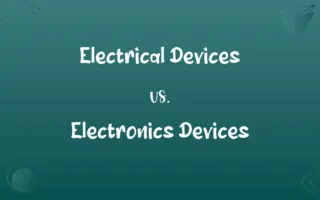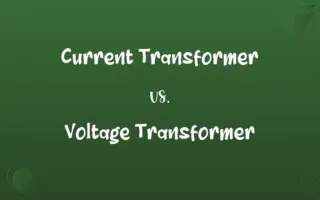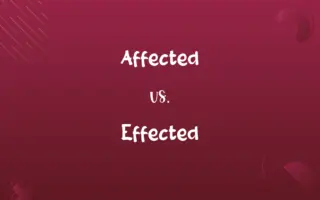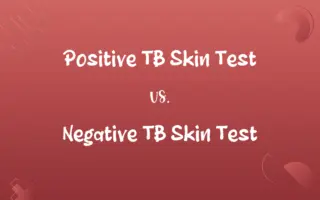Emission Spectra vs. Absorption Spectra: Know the Difference

By Shumaila Saeed || Updated on December 25, 2023
Emission spectra show emitted light wavelengths from excited atoms or molecules, while absorption spectra display absorbed wavelengths, revealing energy transitions in substances.
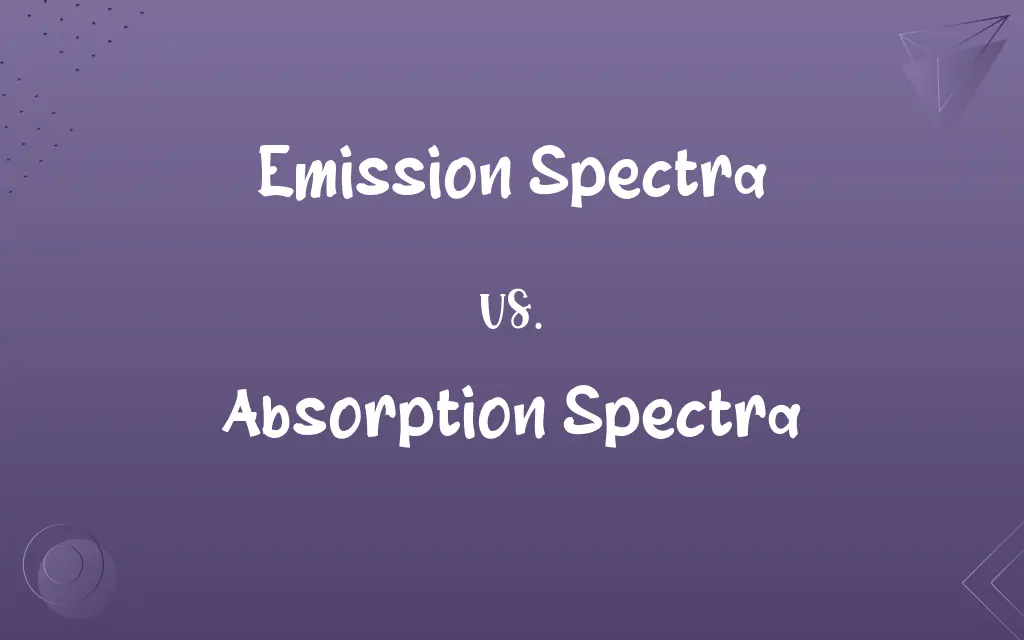
Key Differences
Emission Spectra are the range of wavelengths emitted by a substance when it is energized, usually by heat or electricity. Each element has a unique emission spectrum, like a fingerprint, allowing scientists to identify substances based on the light they emit. Absorption Spectra, in contrast, are formed when substances absorb specific wavelengths of light, leaving dark lines or gaps in a continuous spectrum. This process is crucial in fields like astrophysics for determining the composition of stars.
Shumaila Saeed
Dec 17, 2023
In the Emission Spectra, when an atom or molecule absorbs energy, electrons are excited to a higher energy level, and upon returning to a lower energy state, they emit light at characteristic wavelengths. This results in bright lines against a dark background. Absorption Spectra occur when atoms or molecules in a cooler gas absorb light of specific wavelengths, leading to dark lines in an otherwise continuous spectrum, as seen in sunlight after passing through the Earth's atmosphere.
Shumaila Saeed
Dec 17, 2023
The Emission Spectra can be further divided into three types: continuous, line, and band spectra, depending on the nature of the light source and the substance. Absorption Spectra often complement emission spectra; where emission spectra show bright lines, absorption spectra show corresponding dark lines, helping in understanding the energy transitions within atoms or molecules.
Shumaila Saeed
Dec 17, 2023
Emission Spectra are used in various applications like identifying chemical elements in distant stars, neon signs, and analyzing materials in laboratories. Absorption Spectra are pivotal in techniques like spectroscopy, used for analyzing the chemical composition and physical properties of astronomical objects as well as materials on Earth.
Shumaila Saeed
Dec 17, 2023
In summary, the Emission Spectra represent the emission of light when electrons in an atom or molecule transition to a lower energy state, while Absorption Spectra depict the absorption of specific wavelengths of light when electrons move to a higher energy state.
Shumaila Saeed
Dec 17, 2023
ADVERTISEMENT
Comparison Chart
Physical Process
Electrons drop to lower energy levels
Electrons jump to higher energy levels
Shumaila Saeed
Dec 17, 2023
ADVERTISEMENT
Emission Spectra and Absorption Spectra Definitions
Emission Spectra
Emission Spectra represent the electromagnetic radiation released when atoms return to a lower energy state.
The sun’s emission spectra help scientists identify its elemental composition.
Shumaila Saeed
Dec 04, 2023
Absorption Spectra
Absorption Spectra are characteristic of substances, indicating specific wavelengths they absorb.
UV-Vis spectroscopy uses absorption spectra to determine the concentration of solutions.
Shumaila Saeed
Dec 04, 2023
Emission Spectra
Emission Spectra are the wavelengths of electromagnetic radiation emitted by a substance.
The bright colors in fireworks are due to emission spectra of various elements.
Shumaila Saeed
Dec 04, 2023
Absorption Spectra
Absorption Spectra are the wavelengths of light absorbed by a substance.
Chlorophyll’s absorption spectra, absorbing red and blue light, are fundamental to photosynthesis.
Shumaila Saeed
Dec 04, 2023
Emission Spectra
Emission Spectra show the range of frequencies emitted by atoms or molecules during electron transitions.
A spectroscope reveals the emission spectra of hydrogen as distinct red, blue, and violet lines.
Shumaila Saeed
Dec 04, 2023
ADVERTISEMENT
Absorption Spectra
Absorption Spectra show dark lines or bands where light is absorbed by a material.
The absorption spectra of a star reveal its chemical composition by the dark lines in its spectrum.
Shumaila Saeed
Dec 04, 2023
Emission Spectra
Emission Spectra are the light signature of elements or compounds, displayed as lines or bands.
Neon signs utilize the unique emission spectra of neon to produce glowing colors.
Shumaila Saeed
Dec 04, 2023
Absorption Spectra
Absorption Spectra occur when electrons in an atom or molecule absorb energy and move to a higher energy level.
The absorption spectra of ozone are critical in blocking harmful UV radiation from the sun.
Shumaila Saeed
Dec 04, 2023
Emission Spectra
Emission Spectra are the visual representation of photons emitted by excited atoms or molecules.
The emission spectra of sodium produce the characteristic yellow color in street lamps.
Shumaila Saeed
Dec 04, 2023
Absorption Spectra
Absorption Spectra are visual representations of absorbed photons by materials.
The absorption spectra of pigments determine the colors they impart in art.
Shumaila Saeed
Dec 04, 2023
Repeatedly Asked Queries
What causes Absorption Spectra?
Absorption Spectra occur when substances absorb certain wavelengths of light, causing dark lines in a spectrum.
Shumaila Saeed
Dec 17, 2023
What is a practical use of Emission Spectra?
Emission Spectra are used in neon lights and analyzing astronomical bodies.
Shumaila Saeed
Dec 17, 2023
Can Emission Spectra vary among elements?
Yes, each element has a unique Emission Spectra, acting like a fingerprint.
Shumaila Saeed
Dec 17, 2023
Can Absorption Spectra indicate chemical composition?
Yes, Absorption Spectra can reveal a substance's chemical composition by showing which wavelengths are absorbed.
Shumaila Saeed
Dec 17, 2023
What are Emission Spectra?
Emission Spectra are patterns of light emitted by substances when their atoms release energy.
Shumaila Saeed
Dec 17, 2023
How do Emission Spectra help in science?
Emission Spectra are used to identify elements and compounds based on their unique light patterns.
Shumaila Saeed
Dec 17, 2023
Are Emission and Absorption Spectra always related?
Often, the wavelengths absorbed in Absorption Spectra are the same as those emitted in Emission Spectra.
Shumaila Saeed
Dec 17, 2023
What role do Emission Spectra play in identifying elements?
Emission Spectra help identify elements by analyzing the light they emit at specific wavelengths.
Shumaila Saeed
Dec 17, 2023
Can Emission Spectra be used to measure temperature?
Yes, Emission Spectra can indicate the temperature of a light source based on its spectral characteristics.
Shumaila Saeed
Dec 17, 2023
Do Absorption Spectra vary with different substances?
Yes, each substance has a unique Absorption Spectra based on its composition.
Shumaila Saeed
Dec 17, 2023
Can Emission Spectra be used in medical diagnostics?
Emission Spectra are used in diagnostics, like in analyzing blood samples for specific markers.
Shumaila Saeed
Dec 17, 2023
How are Absorption Spectra applied in astronomy?
Astronomers use Absorption Spectra to determine the elements present in stars and galaxies.
Shumaila Saeed
Dec 17, 2023
What is the role of Absorption Spectra in solar energy research?
Absorption Spectra are important in solar energy for understanding how materials absorb sunlight.
Shumaila Saeed
Dec 17, 2023
How do Absorption Spectra assist in chemical analysis?
Absorption Spectra are used in spectroscopy to analyze the chemical properties of substances.
Shumaila Saeed
Dec 17, 2023
What's the significance of line Emission Spectra?
Line Emission Spectra are significant in determining the electronic structure of atoms.
Shumaila Saeed
Dec 17, 2023
Are Absorption Spectra used in environmental studies?
Absorption Spectra are crucial in studying atmospheric gases and environmental pollutants.
Shumaila Saeed
Dec 17, 2023
Does the state of matter affect Absorption Spectra?
Yes, the state of matter can influence the Absorption Spectra, altering the wavelengths absorbed.
Shumaila Saeed
Dec 17, 2023
Why are dark lines in Absorption Spectra important?
Dark lines in Absorption Spectra indicate specific energies absorbed by atoms, key to understanding atomic structure.
Shumaila Saeed
Dec 17, 2023
How does light source affect Emission Spectra?
The type and intensity of the light source can alter the Emission Spectra of a substance.
Shumaila Saeed
Dec 17, 2023
How does temperature affect Emission Spectra?
Higher temperatures can intensify Emission Spectra and change the wavelengths emitted.
Shumaila Saeed
Dec 17, 2023
Share this page
Link for your blog / website
HTML
Link to share via messenger
About Author
Written by
Shumaila SaeedShumaila Saeed, an expert content creator with 6 years of experience, specializes in distilling complex topics into easily digestible comparisons, shining a light on the nuances that both inform and educate readers with clarity and accuracy.
